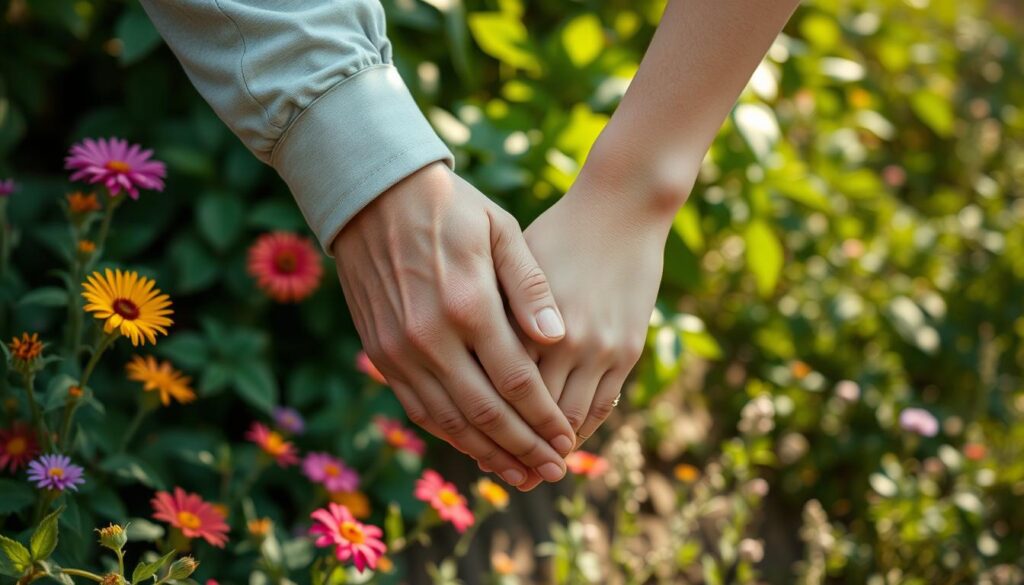
Exploring the intricacies of relationships can be overwhelming. Yet, grasping the signs of a healthy bond is crucial for nurturing lasting connections. In this guide, I’ll explore the key elements that mark a healthy relationship. This knowledge empowers you to evaluate your current relationship and strive for the partnership you desire1.
Trust and mutual respect form the bedrock of a healthy relationship. In such bonds, partners feel secure enough to be open, honest, and true to each other. This creates a solid foundation of integrity and safety2. Effective communication is also vital. It allows couples to tackle obstacles, settle disputes, and share their desires and needs openly and with respect1.
It’s equally important for partners to maintain their individuality within a relationship. While being close and interdependent is key, each person should have the freedom to explore their interests, hobbies, and personal development. This ensures a sense of balance and satisfaction3. The ability to adapt to changes and overcome challenges together also strengthens the bond. It makes the relationship a true partnership3.
Key Takeaways
- Healthy relationships are built on trust, mutual respect, and open communication.
- Partners in a healthy relationship maintain their individual identities and support each other’s personal growth.
- Adaptability, conflict resolution, and a shared commitment to the relationship are essential for long-term success.
- Emotional safety and positive engagement are crucial for the overall health and vitality of the relationship.
- Addressing important topics early on, such as values, goals, and expectations, lays the foundation for a strong and fulfilling partnership.
Essential Signs of a Healthy Relationship
Healthy relationships are founded on trust, mutual respect, and open communication. These elements create a safe space for partners to share their thoughts, emotions, and needs without fear of judgment or backlash4.
Trust and Mutual Respect
Trust is the bedrock of any healthy relationship, encompassing honesty, integrity, and genuine appreciation for each other’s uniqueness. Feeling emotionally and physically secure is crucial for building trust. It allows partners to be open and vulnerable with one another4. Registered psychotherapist Natacha Duke notes that trust grows over time, from small acts of vulnerability to big life decisions made together5.
Open Communication Patterns
Effective communication, even in tough times, is a hallmark of a healthy relationship. Partners engage in both simple and complex conversations, listening actively without judgment and seeking common ground4. Disagreements that lead to compromises strengthen the bond and build trust, key components of a healthy relationship5.
Maintaining Individual Identity
Healthy relationships respect each partner’s unique identity while offering mutual support for growth. It’s important to maintain connections with family, friends, and personal interests outside the relationship for personal space and growth4. Sharing similar values and goals is also crucial, as they form the foundation of the relationship5.
Being curious about each other’s thoughts, goals, and personal development is vital in a healthy relationship. It ensures partners remain engaged in each other’s lives4. Feeling that your partner is committed to the relationship is the top indicator of a healthy relationship, as found in a 2020 review of relationship studies6.

By nurturing trust, open communication, and respecting individual identities, couples can create a strong, enduring bond. This bond supports personal growth and compatibility4. Kindness, shown through mutual support, active listening, apologies, and feeling safe, is essential in a healthy relationship5.
“Having a healthy relationship means being able to be your authentic self, feel heard and understood, and have your needs met in a mutually beneficial way.”
How to Know if a Relationship is Healthy
Keeping a relationship healthy and fulfilling is vital for our emotional health and life happiness. To see if your relationship is on the right path, look for key signs of a healthy dynamic7.
Mutual trust and respect are crucial in a healthy relationship. When both partners feel heard, understood, and valued, they experience emotional fulfillment and equality8.
- A survey found that 85% of people believe clear boundaries are key to a healthy partnership7.
- Healthy relationships are built on mutual respect, listening, understanding, and uplifting each other8.
Open and honest communication is another vital sign of a healthy relationship. When partners can share their thoughts, feelings, and needs freely, they can overcome challenges and strengthen their bond8.
It’s also important for partners to maintain their individuality and pursue their interests and goals. Healthy relationships support personal growth and fulfillment, not control or change9.

Red flags in a relationship include trying to control or change the other, disrespecting boundaries, feeling distant or relieved when apart, and consistently negative or hurtful communication. These signs may indicate an unhealthy dynamic that needs attention or could mean the relationship should end8.
“Healthy relationships are marked by compassionate and passionate love, with the initial passion evolving into deeper intimacy over time.”8
In summary, a healthy relationship is one that brings emotional fulfillment, mutual respect, and equality. By recognizing these signs, you can work towards a strong, meaningful connection with your partner.
Setting and Maintaining Healthy Boundaries
Creating and maintaining healthy boundaries is essential for building strong, meaningful relationships. These boundaries cover physical, emotional, digital, and material aspects. Together, they ensure personal space and mutual respect10.
Physical and Emotional Boundaries
Physical boundaries might include how much public affection we show or our need for personal space. Emotional boundaries concern how much we share our feelings and our emotional availability. Clear expectations in these areas prevent misunderstandings and foster security in relationships10.
Digital and Material Boundaries
In today’s digital world, boundaries around social media, phone privacy, and shared possessions or finances are vital. Discussing these boundaries openly with partners, friends, and family ensures a balance between connection and independence11.
Responding to Boundary Violations
Boundaries may be crossed, either by mistake or on purpose. It’s key to talk openly and honestly about these violations and respond in a way that reinforces the boundaries. This might mean setting consequences or redefining the boundary, all while keeping the conversation constructive10.
Healthy boundaries are dynamic, changing as our relationships and needs evolve. Regularly reviewing and adjusting these boundaries helps maintain security, respect, and trust in our connections10.
“Establishing healthy boundaries is an act of self-love. It’s about honoring your needs and respecting yourself, which in turn allows you to have more authentic and fulfilling relationships.”
Building and Sustaining a Strong Connection
Creating a lasting, fulfilling relationship goes beyond physical closeness. It’s about building a deep emotional bond12. Good communication is key to a healthy relationship12. Couples who talk openly experience a stronger emotional tie12. Face-to-face interactions positively affect the brain and nervous system in relationships12. Regular quality time together strengthens the bond and sense of shared goals12.
Trying new things together keeps the relationship exciting12. Engaging in activities both partners enjoy outside of the relationship also fosters connection12. Volunteering for a cause can be incredibly rewarding. It boosts happiness in both individuals and relationships1213.
Strong relationships need a constant commitment to open, honest communication12. Nonverbal cues like eye contact, tone, and gestures are crucial in communication12. Prioritizing quality time, shared experiences, and a sense of purpose keeps the emotional connection strong12.
“The greatest gift you can give another is the purity of your attention.” – Richard Moss
Conclusion
Maintaining a healthy, long-lasting relationship demands continuous dedication and effort14. It involves open communication, respecting boundaries, and encouraging mutual growth. This approach helps couples build a fulfilling partnership, boosting their happiness and wellbeing15. Studies show that healthy relationships can lead to lower stress, better healing, healthier behaviors, and even longer life expectancy15.
Finding a compatible partner and falling in love might seem easy. Yet, sustaining a strong connection over time requires constant effort and commitment14. Healthy relationships are built on trust, honesty, and mutual respect. They allow couples to maintain their individuality while nurturing their shared bond14. Setting and respecting healthy boundaries creates a safe environment for growth and trust.
The essence of long-term relationship maintenance is prioritizing communication, quality time, and mutual support14. Engaging in open dialogue, finding common interests, and celebrating each other’s successes strengthens the bond. This way, couples can face life’s challenges together, deepening their connection and personal growth14.
